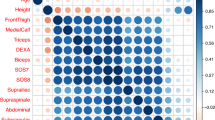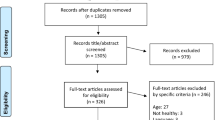Abstract
In elite Gaelic football, body composition is commonly assessed by methods, such as skinfold equations and dual-energy X-ray absorptiometry (DXA) with estimates of body fat used to evaluate and monitor nutrition and training programmes. The aim of this study was to assess the accuracy and variability of the existing skinfold equations in predicting body fat % (BF%) and fat mass (FM) as compared to DXA in elite Gaelic football players and to derive novel sport-specific skinfold equations. Body composition in thirty-two elite outfield Gaelic football players (23.4 ± 3.3 years; 83.6 ± 7.2 kg; 183.5 ± 6.4 cm) was assessed via skinfold thickness at 7 sites and DXA. A standardised testing protocol was followed for both methods of assessment. Male-specific prediction equations commonly used in Gaelic football research to estimate BF% (Durnin and Womersley, Evans, Lohman, Reilly and Withers) and FM (Stewart) were selected. Using the skinfold data collected, Gaelic football prediction equations were developed relative to DXA. All the existing skinfold equations underestimated BF% (8.9–11.8%) and FM (6.8 kg) by varying magnitudes relative to DXA (15.2%; 11.8 kg). Gaelic football prediction equations for BF% and FM were designed and accounted for 69% and 76% variance in DXA derived BF% and FM, respectively. The existing skinfold equations demonstrated large variation in estimates of BF% and FM in elite Gaelic football players as compared to DXA, causing the potential for misleading comparisons and inappropriate intervention. The Gaelic football equations offer sport-specific estimates of BF% and FM and greater consistency as compared to the selected equations when evaluating nutrition and training strategies.


Similar content being viewed by others
References
Beasley KJ (2014) Nutrition and Gaelic football: review, recommendations and future considerations. Int J Sport Nutr Exerc Metab. https://doi.org/10.1123/ijsnem.2013-0214
Mangan S, Ryan M, Shovlin A et al (2019) Seasonal changes in Gaelic football match-play running performance. J Strength Cond Res 33:1685–1691. https://doi.org/10.1519/JSC.0000000000002269
Catháin CÓ, Fleming J, Renard M, Kelly DT (2020) Dietary intake of Gaelic football players during game preparation and recovery. Sports. https://doi.org/10.3390/sports8050062
McGahan J, Burns C, Lacey S et al (2020) Investigation in to the positional running demands of elite Gaelic football players: how competition data can inform training practice. J Strength Cond Res 34:2040–2047. https://doi.org/10.1519/JSC.0000000000002492
Shovlin A, Roe M, Malone S, Collins K (2018) Positional anthropometric and performance profile of elite Gaelic football players. J Strength Cond Res 32:2356–2362. https://doi.org/10.1519/JSC.0000000000002071
Davies RW, Toomey C, McCormack W et al (2016) Body composition analysis of inter-county Gaelic athletic association players measured by dual energy X-ray absorptiometry. J Sports Sci 34:1015–1020. https://doi.org/10.1080/02640414.2015.1085076
Doran DA, Mc Geever S, Collins KD et al (2014) The validity of commonly used adipose tissue body composition equations relative to dual energy X-ray absorptiometry (DXA) in gaelic games players. Int J Sports Med 35:95–100. https://doi.org/10.1055/s-0033-1333693
Cullen BD, Cregg CJ, Kelly DT et al (2013) Fitness profiling of elite level adolescent gaelic football players. J Strength Cond Res 27(8):2096–2103
Kelly R, Collins K (2018) The Seasonal variations in anthropometric and performance characteristics of elite intercounty Gaelic football players. J Strength Cond Res 32:3466–3473. https://doi.org/10.1519/jsc.0000000000001861
Aragon AA, Schoenfeld BJ, Wildman R et al (2017) International society of sports nutrition position stand: diets and body composition. J Int Soc Sports Nutr 14:16. https://doi.org/10.1186/s12970-017-0174-y
Larson-Meyer DE, Woolf K, Burke L (2018) Assessment of nutrient status in athletes and the need for supplementation. Int J Sport Nutr Exerc Metab 28:139–158. https://doi.org/10.1123/ijsnem.2017-0338
Suarez-Arrones L, Petri C, Maldonado RA et al (2018) Body fat assessment in elite soccer players: cross-validation of different field methods. Sci Med Footb 2:203–208. https://doi.org/10.1080/24733938.2018.1445871
Hind K, Slater G, Oldroyd B et al (2018) Interpretation of dual-energy X-ray absorptiometry-derived body composition change in athletes: a review and recommendations for best practice. J Clin Densitom 21:429–443. https://doi.org/10.1016/j.jocd.2018.01.002
Gomes AC, Landers GJ, Binnie MJ et al (2020) Body composition assessment in athletes: comparison of a novel ultrasound technique to traditional skinfold measures and criterion DXA measure. J Sci Med Sport. https://doi.org/10.1016/j.jsams.2020.03.014
Ackland TR, Lohman TG, Sundgot-Borgen J et al (2012) Current status of body composition assessment in sport: review and position statement on behalf of the ad hoc research working group on body composition health and performance, under the auspices of the I.O.C. Medical Commission. Sports Med Auckl NZ 42:227–249. https://doi.org/10.2165/11597140-000000000-00000
Bilsborough JC, Greenway K, Opar D et al (2014) The accuracy and precision of DXA for assessing body composition in team sport athletes. J Sports Sci 32:1821–1828. https://doi.org/10.1080/02640414.2014.926380
Durnin JVGA, Womersley J (1974) Body fat assessed from total body density and its estimation from skinfold thickness: measurements on 481 men and women aged from 16 to 72 Years. Br J Nutr 32:77–97. https://doi.org/10.1079/BJN19740060
Jackson AS, Pollock ML (1978) Generalized equations for predicting body density of men. Br J Nutr 40:497–504. https://doi.org/10.1079/bjn19780152
Reilly T, George K, Marfell-Jones M et al (2009) How well do skinfold equations predict percent body fat in elite soccer players? Int J Sports Med 30:607–613. https://doi.org/10.1055/s-0029-1202353
Boyle E, Warne J, Collins K (2021) Anthropometric and performance profile of elite Gaelic football players comparing position and role. Sport Sci Health 17:763–770. https://doi.org/10.1007/s11332-021-00758-3
McIntyre MC, Hall M (2005) Physiological profile in relation to playing position of elite college Gaelic footballers. Br J Sports Med 39:264–266. https://doi.org/10.1136/bjsm.2003.011254
Lohman TG (1981) Skinfolds and body density and their relation to body fatness: a review. Hum Biol 53:181–225
Withers RT, Craig NP, Bourdon PC, Norton KI (1987) Relative body fat and anthropometric prediction of body density of male athletes. Eur J Appl Physiol 56:191–200
Meyer N, Sundgot-Borgen J, Lohman TG, Ackland T, Stewart A, Maughan RJ, Smith S, Mueller W (2013) Body composition for health and performance: a survey of body composition assessment practice carried out by the Ad Hoc Research Working Group on Body Composition, Health and Performance under the auspices of the IOC Medical Commission, vol 47
Hume P, Marfell-Jones M (2008) The importance of accurate site location for skinfold measurement. J Sports Sci 26:1333–1340. https://doi.org/10.1080/02640410802165707
Kerr A, Slater GJ, Byrne N (2017) Impact of food and fluid intake on technical and biological measurement error in body composition assessment methods in athletes. Br J Nutr 117:591–601. https://doi.org/10.1017/S0007114517000551
Stewart A, Marfell-Jones M, Olds T, De Ridder J (2011) International standards for anthropometric assessment. ISAK, Lower Hutt
Evans EM, Rowe DA, Misic MM et al (2005) Skinfold prediction equation for athletes developed using a four-component model. Med Sci Sports Exerc 37:2006–2011
Stewart AD, Hannan WJ (2000) Prediction of fat and fat-free mass in male athletes using dual X-ray absorptiometry as the reference method. J Sports Sci 18:263–274. https://doi.org/10.1080/026404100365009
Siri WE (1956) The Gross Composition of the Body. The author’s investigations were supported by a contract between the AEC and the University of California, Berkeley. In: Lawrence JH, Tobias CA (eds) Advances in biological and medical physics. Elsevier, Oxford, pp 239–280
Nana A, Slater GJ, Stewart AD, Burke LM (2015) Methodology review: using dual-energy X-ray absorptiometry (DXA) for the assessment of body composition in athletes and active people. Int J Sport Nutr Exerc Metab 25:198–215. https://doi.org/10.1123/ijsnem.2013-0228
Hopkins WG, Marshall SW, Batterham AM, Hanin J (2009) Progressive statistics for studies in sports medicine and exercise science. Med Sci Sports Exerc 41:3–13. https://doi.org/10.1249/MSS.0b013e31818cb278
Bland JM, Altman DG (1986) Statistical methods for assessing agreement between two methods of clinical measurement. Lancet Lond Engl 1:307–310
Eston RG, Rowlands AV, Charlesworth S et al (2005) Prediction of DXA-determined whole body fat from skinfolds: importance of including skinfolds from the thigh and calf in young, healthy men and women. Eur J Clin Nutr 59:695–702. https://doi.org/10.1038/sj.ejcn.1602131
Zemski A, Broad E, Slater G (2017) Skinfold prediction equations fail to provide an accurate estimate of body composition in elite rugby union athletes of caucasian and polynesian ethnicity. Int J Sport Nutr Exec Metab 28:90
Wells JCK, Fewtrell MS (2006) Measuring body composition. Arch Dis Child 91:612–617. https://doi.org/10.1136/adc.2005.085522
Silva AM, Fields DA, Quitério AL, Sardinha LB (2009) Are skinfold-based models accurate and suitable for assessing changes in body composition in highly trained athletes? J Strength Cond Res 23:1688–1696. https://doi.org/10.1519/JSC.0b013e3181b3f0e4
Collins K, Hughes B, Keenan B, Kennedy M (2013) Effect of high-intensity interval training on elite Gaelic football players. BASES - Conference Proceedings Archive [Internet]. Available from: https://www.academia.edu/29372848/Effect_of_High_Intensity_Interval_Training_on_Elite_Gaelic_Football_Players
Dunne A, Warrington G, O’Loughlin G et al (2020) Estimation of body fat percentage in jockeys: implications for a weight category sport. Int J Exerc Sci 13:511–525
Earthman CP (2015) Body composition tools for assessment of adult malnutrition at the bedside: a tutorial on research considerations and clinical applications. J Parenter Enter Nutr 36:787
Funding
This research was supported by the Irish Injured Jockeys Fund, Munster Technological University and Waterford Institute of Technology.
Author information
Authors and Affiliations
Corresponding author
Ethics declarations
Conflict of interest
The authors have nothing to declare regarding any potential conflicts of interest which may be perceived as prejudicing the impartiality of the research reported.
Ethical approval
All procedures were approved by the host institution’s research ethics committee and all procedures were in accordance with the Declaration of Helsinki.
Informed consent
All participants provided written informed consent.
Additional information
Publisher's Note
Springer Nature remains neutral with regard to jurisdictional claims in published maps and institutional affiliations.
Rights and permissions
About this article
Cite this article
Dunne, A., O’Neill, C., Warrington, G. et al. Variability and accuracy of body fat estimates using skinfolds and DXA in elite Gaelic football players: a validation study and development of novel prediction equations. Sport Sci Health 18, 1263–1272 (2022). https://doi.org/10.1007/s11332-022-00896-2
Received:
Accepted:
Published:
Issue Date:
DOI: https://doi.org/10.1007/s11332-022-00896-2




